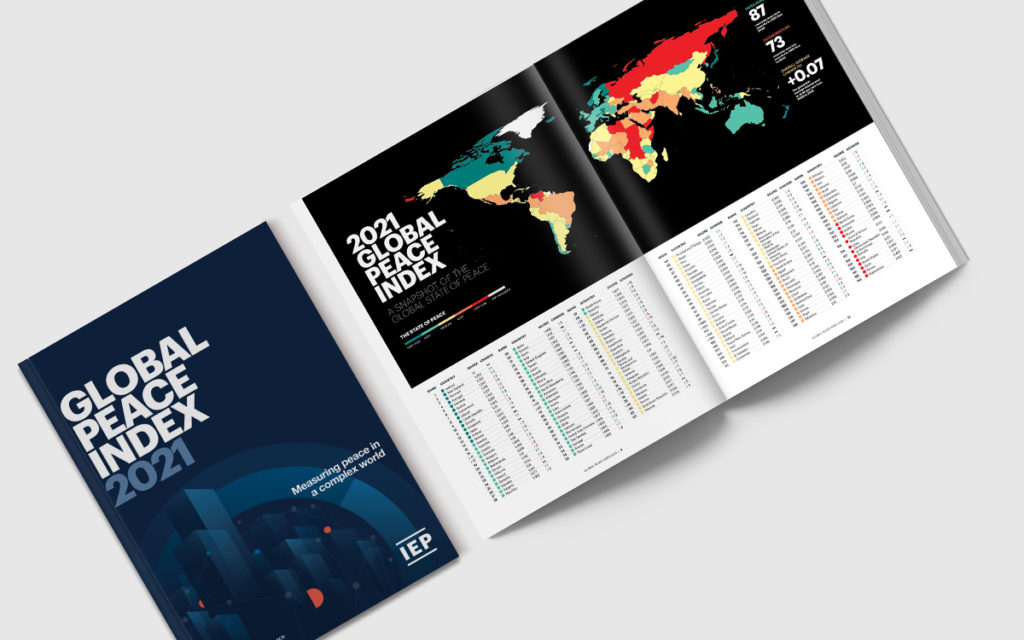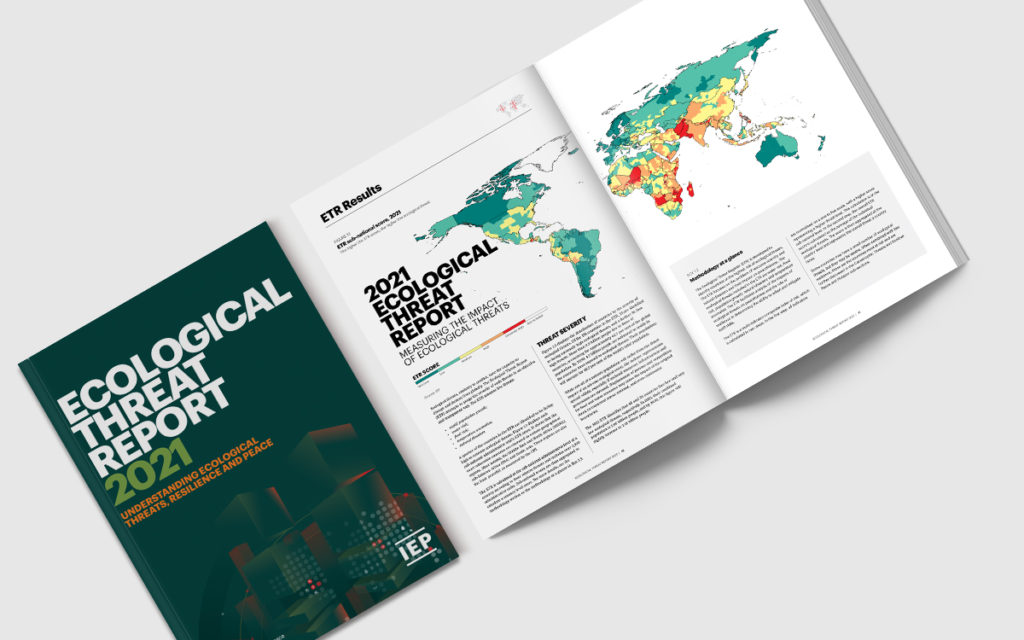Positive Peace indicators, such as group grievances, perceptions of corruption, deteriorating income distribution, fractionalised elites, continue to fall amidst high unemployment, large debts and slow economic recovery and exists a general level of uncertainty that puts a pall across investment. The next five years could continue to be challenging with economic turmoil caused by the pandemic lingering, pressure testing societal fragilities.
On a more positive note, ecological threats have also been in focus this year, with the 2021 United Climate Change Conference, better known as COP26 bringing together many major world leaders to discuss how we may all address the climate change emergency. In preparation for COP26, we released our second iteration of the Ecological Threat Register, which gauged global ecological threats and how each country is positioned to address these threats now, and in the future.

The ETR recorded more the 7 billon media impressions and our other annualised major products, the Global Peace Index and Global Terrorism Index, also went well recording another 13 billion media impressions between them.
At the Institute for Economics & Peace, we are working towards a paradigm shift in the way we develop our societies, shifting them towards peace. Our Positive Peace framework contains the very factors that create peace and also generate the background conditions for many of the things we value to flourish, such as higher per capita income, better performance on measures of wellbeing and happiness, stronger performance on ecological measures, to name a few.
Our strategic partnerships with other organisations have strengthened over the last year, with World Vision and IEP signing a MOU this year and plan to roll out a number of project in Iraq and beyond. We continue to spread Positive Peace with Rotary International and have begun to build regional groups of Positive Peace “activators” or facilitators within local Rotary clubs around the world. One of the world’s largest coalitions of grassroots interfaith groups, Religions for Peace, partnered with us and will implement IEP’s Positive Peace framework and workshops through its network.
There is no doubt that we are living in an uncertain period in history. And yet the world now has an opportunity to reset, but unless we approach global problems with new approaches we won’t meet these challenges. Peace is a perquisite for the survival of humanity – without it we will never develop the levels of trust, cooperation or inclusiveness necessary to solve our global challenges.

The Global Peace Index (GPI) is composed of 23 qualitative and quantitative indicators from highly respected sources, and now ranks 163 independent states and territories, covering over 99 per cent of the world’s population. The index gauges’ global peace using three broad themes: the level of safety and security in society; the extent of domestic or international conflict; and the degree of militarisation. The most recent edition of the GPI found that over the past ten years the overall levels of peace had slightly deteriorated, with the level of political and civil unrest continuing to rise around the world. It also drew on data from the Lloyd’s Register Foundation World Risk Poll, to examine trends in perceptions of risk and safety prior to the COVID-19 pandemic. The 2021 GPI received a high level of domestic and international media coverage as well as being the subject of a large number of launch events hosted around the globe. Notable press coverage included, Financial Times, Reuters, The Guardian, BBC, The New York Times and Bloomberg.
The next iteration of the Global Terrorism Index will be released in March 2022. This will mark the first time that the GTI will use data from Dragonfly’s Terrorism Tracker database. This will allow for IEP to undertake near real-time analysis of emerging threats from terrorism, and ensure that all GTI releases contain the most up to date data, trends, and analysis. The next GTI will focus on the continued growth of terrorism in the Sahel, further extending the analysis that was a key part of the 2021 Ecological Threat Report.

The second edition of the Ecological Threat Register (ETR) identifies countries at the highest risk of ecological threats. The report focuses on the problem of resource scarcity and natural disasters and their impact on peacefulness. Analysis from the ETR allows for the identification of countries and regions where ecological crises are more likely to occur and have a severe impact on populations residing in those areas. A multi-indicator composite index of ecological threat, the ETR is calculated using five indicators whereby all indicators are normalised on a score of 1 to 5 with a higher score representing higher levels of exposure. The ETR count represents the number of threats a country faces such as water and food risk and natural disasters. Key findings from the report demonstrate the important nexus between peace and resource scarcity threats, such as the finding that the global population is projected to reach ten billion by 2050 with the majority of the growth taking place in the world’s least peaceful countries. By 2050, the ETR found that 80 per cent of the world’s population will live in countries that are in the bottom half of the Global Peace Index rankings.
As we end 2021, we’d like to say a massive ‘thank you’ to our audiences, partners, clients and the press for helping us in our mission to create a paradigm shift in the way the world thinks about peace.